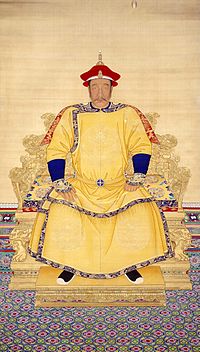
Back نورهس Arabic نورهس ARZ ནུའུ་ཨར་ཧ་ཁྲི། Tibetan Nurhaci Catalan Nū-ī-hăk-cà̤ CDO Nurhači Czech Nurhaci Danish Nurhaci German Nurhaci Spanish Nurhaci Estonian
| Nurhaci 努爾哈赤 | |||||||||||||||||||||
|---|---|---|---|---|---|---|---|---|---|---|---|---|---|---|---|---|---|---|---|---|---|
| Khan of Great Jin | |||||||||||||||||||||
 | |||||||||||||||||||||
| Khan of the Later Jin dynasty | |||||||||||||||||||||
| Reign | 17 February 1616 – 30 September 1626 | ||||||||||||||||||||
| Successor | Hong Taiji | ||||||||||||||||||||
| Born | 14 May 1559 (嘉靖三十八年 四月 初八日) Hetu Ala, Manchuria, Ming | ||||||||||||||||||||
| Died | 30 September 1626 (aged 67) (天命十一年 八月 十一日) Aijipu, Later Jin | ||||||||||||||||||||
| Burial | |||||||||||||||||||||
| Consorts | Tunggiya Hahana Jacing
(m. 1577; died 1592)Fuca Gundei
(m. 1585; died 1620) | ||||||||||||||||||||
| Issue | |||||||||||||||||||||
| |||||||||||||||||||||
| House | Aisin-Gioro | ||||||||||||||||||||
| Dynasty | Later Jin | ||||||||||||||||||||
| Father | Taksi | ||||||||||||||||||||
| Mother | Empress Xuan | ||||||||||||||||||||
Nurhaci (14 May 1559 – 30 September 1626), also known by his temple name as the Emperor Taizu of Qing, was the founding khan of the Jurchen-led Later Jin dynasty of China from 1616 to 1626.
As the leader of the House of Aisin-Gioro, Nurhaci reorganized and united various Jurchen tribes (the later "Manchu"), consolidated the Eight Banners military system, and eventually launched attacks on both the Ming and Joseon dynasties. His conquest of Ming dynasty's northeastern Liaodong region laid the groundwork for the Qing conquest of the Ming by his descendants, who proclaimed the Qing dynasty in 1636. He is also generally credited with ordering the creation of a new written script for the Manchu language based on the Mongolian vertical script.
© MMXXIII Rich X Search. We shall prevail. All rights reserved. Rich X Search